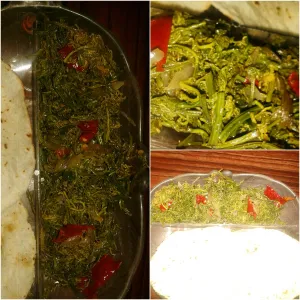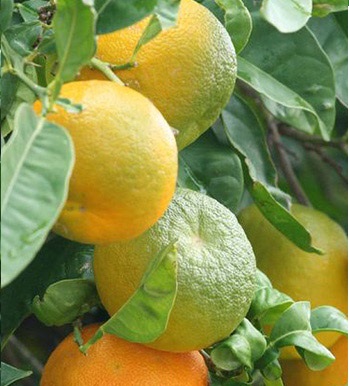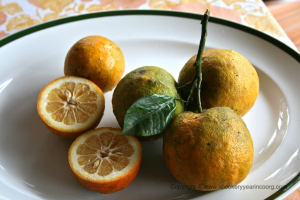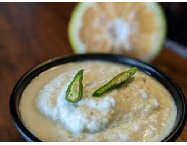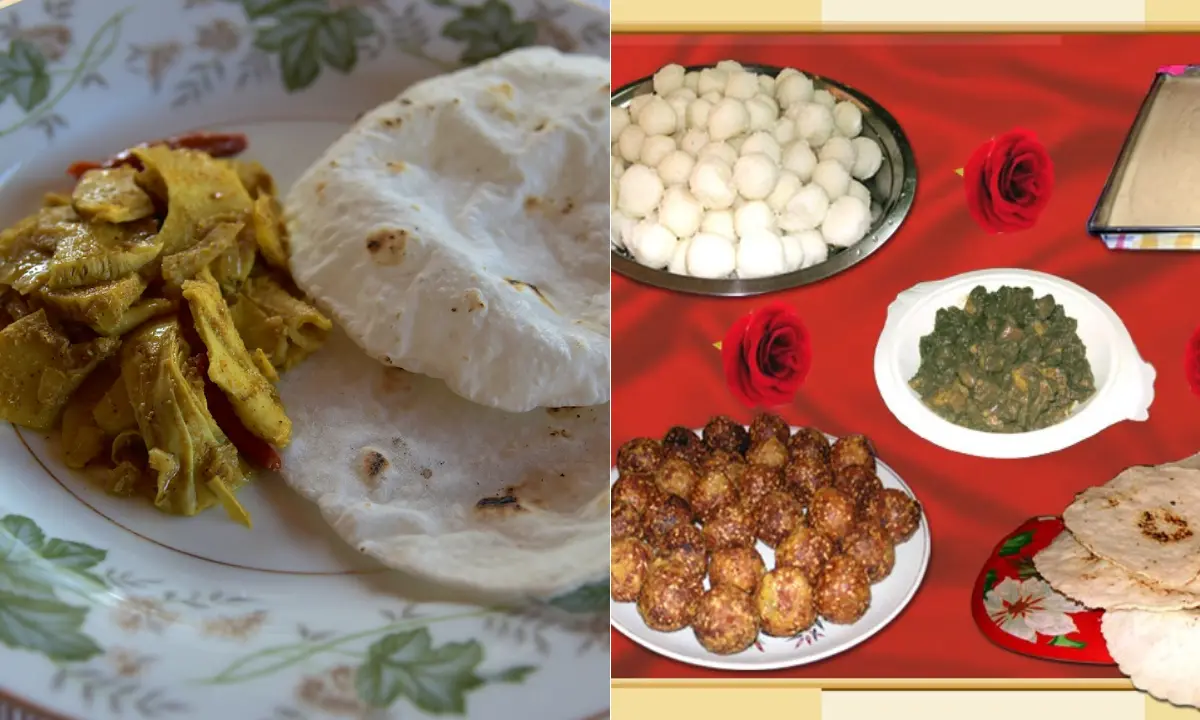
Recipies
Kaipuli (bitter orange) Recipes by Shalini Nanda
Kaipuli, or bitter orange, with its tart flesh and beguiling bitter-sweet fragrance, is a star in the Kodava culinary repertoire.
Kaipuli is prepared in various ways, using the juice, pulp and also the whole fruit. The most popular ways to prepare kaipuli are in kaipuli pajji, which incorporates the fresh pulp in a yogurt base; chutta kaipuli pajji, a cooked chutney made from the pulp of roasted kaipuli; and pulikuul paaka, another cooked pickle made using the juice of kaipuli. The fruit is also pickled with salt, chilli powder and spices.
Kaipuli juice, mixed with equal parts by volume of sugar and left in the intense sun for a few days will soon develop into a marvellously refreshing concentrateT.
Three chutney recipes follow, but let’s begin with how to prep the fruit.
For kaipuli pajji, you’ll need peeled and deseeded segments.
Using a small, sharp knife, slice off the peel and pith on the top and bottom of the fruit, then cut away the skin, pith and outer membrane in vertical slices to reveal the inner juicy flesh. Slice out inner segments between the membrane. Save any juice that spills out. Remove any seeds that come away with the fruit.
For chutta kaipuli pajji, you need the cooked inner flesh of fruit that has been roasted.
Wash the fruit and wipe it dry. Arrange on glowing embers and roast gently, turning the fruit to cook evenly. It’s ready when the entire fruit is blackened and soft. This takes at least 15-20 minutes on embers, less if you’re doing it over a gas flame.Place each roasted fruit gently in a bowl of cold water to cool and and wash off the soot, ashes and any charred portions of peel. Slice into quarters and scoop out the pulp into a bowl, taking care to remove all the seeds.
For pulikuul paaka, only the juice is needed. Extract this the way you would juice oranges.
Substituting Seville oranges for kaipuli
In my experience, Seville oranges tend to be more tart, and less juicy than kaipuli, so substitution of one for the other requires a little tweaking. The most important flavour here lies in the rind, so incorporating that into the recipe is important. The simplest way to go about this is to make pulp of the seville oranges, to be used in suitable proportions in the following recipes.
Seville orange pulp
Wash and dry your Seville oranges. If using frozen, thaw them completely before cooking.
Wipe the surface of each orange with a few drops of oil, then wrap each one loosely in foil, place on a tray and bake at 375 C for about 35-40 minutes, or until the fruit is tender but still holding its shape.
Place these baked oranges under the broiler at 525 C for as long as it takes to roast the outsides to a dark brown-black. Make sure they are on a non-reactive tray that will contain any juice that escapes.
Since the peel will be used in the recipes, you can decide to what degree you wish to roast the fruit. I like my Seville orange on the smoky side, so usually allow for more charred bits!
Let the fruit cool, then cut into wedges and carefully remove all the seeds to a bowl. Add the juice of a few lemons to the seeds to help remove the pulp that clings to them. Strain the seeds out, put the extracted pulp and chopped peel in the food processor and grind to a coarse paste.
Your kaipuli substitute is ready for use, or ready to freeze for use on another day.
Recipes
Fresh kaipuli pajji
- 3 cups thick yogurt, lightly whipped
- 2 1/2 cups of peeled and deseeded segments of ripe kaipuli
- •or
- 1 tbsp Seville orange pulp and peeled and deseeded segments of grapefruit or pomelo
Put the fruit and juice in a bowl along with salt and sugar to taste.
Grind together:
- 1/2 cup freshly grated coconut
- 2-3 hot green chillis
- 2-3 cloves of garlic
- 1 small bunch of fresh coriander
- 1 tsp mustard seed (for version 1) powdered separately if your grinder won’t do the job
Seasoning:
- 1-2 tbsp oil (use a little more for version 3)
- I tsp mustard seed (for versions 2 and 3)
- 1 small sprig of curry leaves
- 1/4 cup finely chopped shallots
- 2 red chillis, broken into large pieces
Heat the oil and sputter the mustard, add the red chillis and curry leaves, then the shallots and fry till lightly browned.
There are several ways in which to interpret this recipe:
- In the first version, the ground coconut paste is added to the yogurt and combined with the kaipuli. The seasoning is then poured over. The masala remains raw, so if you have trouble dealing with garlic in its uncooked form, this is not for you!
- In this version, the ground coconut paste is added to the seasoning after the shallots are browned and cooked briefly to take the raw edge off the garlic. Then all the ingredients are combined.
- The third version involves starting off with the seasoning step, then adding the ground coconut masala (see the notes about mustard and oil in the recipe above) followed by the yogurt. The whole mixture is heated through gently, then combined with the fruit.
Kaipuli pajji makes a delicious accompaniment to a rich pulao, though I find it hard to resist eating this on its own.
Serves 6-8 as a side dish.
Chutta kaipuli pajji
A cooked chutney made with the flesh of roasted kaipuli.
- 1 cup of roasted kaipuli pulp
- •or
- 1 cup Seville orange pulp and 1/2 cup lemon juice (The orange pulp is much drier than kaipuli, so the lemon juice adds moisture)
- 1 cup of fresh grated coconut, gently toasted to a golden brown
- 12-15 cloves of garlic
- 1 tbsp cumin
- 1 tbsp mustard seed
- 1 tsp whole black peppercorns
- 5-6 red chillis
- 1 tbsp thick tamarind extract (you may add a little more if using the sweeter thai variety)
- 150 gms powdered jaggery
- 2 1/2 tbsp rock salt, or to taste
Seasoning:
- 1/3 cup raw sesame oil
- 1 tsp mustard
- 2-3 red chillis, broken into large bits
- 2 sprigs curry leaves
- 1 medium onion, finely chopped
Mix the salt into the kaipuli pulp and set aside.
Dry roast the cumin, mustard, pepper and chillis separately. Grind the spices together before combining with the garlic and coconut and grind to a rough paste.
Heat the oil in a non-reactive pan and sputter the mustard. Then add the curry leaves and broken red chillis, followed by the chopped onion. When the onions start to brown, add the ground spice paste and fry on low heat for a few minutes until the garlic no longer smells raw.
Add the tamarind and jaggery and continue cooking for another 4-5 minutes or until the oil begins to separate from the mixture.
Cool and bottle.
Makes about 1 1/2 cups.
The smoky, hot-sour sweetness of this chutney combines wonderfully with lots of things. Try it with grilled pork chops, salmon, or in a cheese and chutney sandwich!
Pulikuul Paaka
- 1 1/2 cups kaipuli juice
- •or
- 1/4 cup seville orange pulp, ground to a fine paste, and enough lemon juice to make up the remaining volume
- 5-6 green chillis, or to taste
- 12 cloves of garlic
- 75-100 gms powdered jaggery , or to taste
- 2 cups fresh grated coconut, lightly toasted to a golden brown
- 1 tbsp thick tamarind paste
- 2 tbsp rock salt, or to taste
Lightly roast and powder together:
- 1/2 tbsp cumin
- 1/2 tsp black peppercorns
- 1/4 tsp fenugreek seed
Grind all of the above ingredients together to a smooth paste.
Seasoning;
- 1-2 red chillis, deseeded and broken into large pieces
- 1/2 tbsp channa dal (soaked for 20 minutes and drained)
- 2 tbsp roasted , skinned peanuts
- 1 sprig curry leaves
- 4-5 tbsp raw sesame oil
In a shallow, non-reactive an, heat the oil, then add the curry leaves and red chillis, followed by the channa dal and the peanuts. Saute until the the dal turns golden brown. Pour in the ground mixture , taking care to avoid the spattering that ensues when liquid hit hot oil!
Cook on medium low, stirring occasionally, until the mixture begins to thicken and the oil begins to separate. This may take about 10-15 minutes.
Remove from heat, cool, and bottle.
Makes about 1 1/2 cups.
Mix Pulikuul paaka into freshly cooked rice for a Kodava version of puliyogare, or just eat it as a pickle on the side. Or any way you like.
Gallery
Categories
Food Recipies you may like
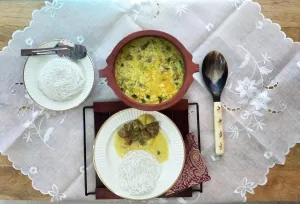
COORG YERCHI STEW (MUTTON STEW) by Rachel Bheemaiah
Learn more
MULBERRY WINE & KOLI CURRY WITH A TWIST BY Smitha Iyanna
Learn more